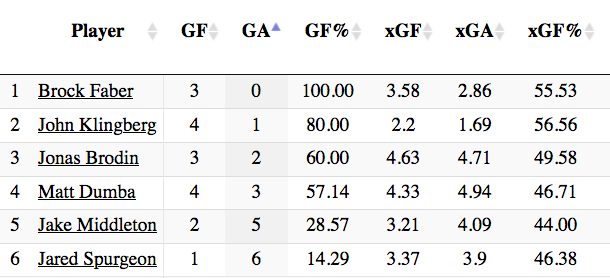
Another early summer for the Wild came with a silver lining: Local product Brock Faber seems poised to break out in 2023-24.
Mere days after the end of his college career, the 20-year-old made his NHL debut. A week later, he was thrown into the postseason gauntlet—and he fared so well that a full-time role on Dean Evason’s blue line is now a formality.
Here’s how Faber impressed in his brief big-league stint.
Gap Control
In case you missed the memo, Evason’s squad bears little resemblance to your dad’s Minnesota Wild. There’s no settling into a trap. They apply heavy puck pressure in order to gum up the works as soon as possible.
This fits Faber’s skating like a glove. His blinding short-area burst, in particular, allows him to stand his ground without fear of blowing containment.
He can recover from miscalculations in a heartbeat.
In addition, he’s a naturally confident defender who stays on his toes. He eats ample real estate and will hover just close enough to the action to make puck-carriers sweat. Therefore, trying to cross the blue line with control is a low-percentage move. Chip and chase, and he’ll turn, burn and often still win the race:
Faber gives himself plenty of rope to deny cheap entries. His self-assuredness also translates to aggressive pursuit angles—he’ll fly over to his partner’s side if that will derail offensive momentum. When forwards might expect a cushion, he’s already sitting in their hip pocket.
Even in his first playoff series, he was gapping up with ease:
Notice how he handles Mason Marchment (DAL 27) here. Due to his mobility and savvy stick placement, he can launch his approach from a higher depth and simply erase the middle of the ice. By the time the Stars forward thinks better of a risky play, Faber has him stuck in a box.
The result? A breakaway for Kirill Kaprizov (MIN 97).
Faber’s gift for holding the blue line puts out fires before a puff of smoke ever rises into view. It’s no shocker, then, that he delivered sparkling defensive metrics in Round 1. Among Wild rearguards, he conceded the second-fewest shot attempts and fewest expected goals:

It’s worth noting that he and John Klingberg didn’t see much of Dallas’ top six, but cocooning the latter is a tough assignment for any defenseman—let alone a 20-year-old. Faber passed the test with flying colors.
His pace, zeal and pesky stick consistently dulled Dallas’ outlook.
D-Zone Fundamentals
Though modern defensive blueliners are comfortable in space, the ability to stave off opponents when the ice shrinks remains a priceless tool. Faber shone in this regard during his eight games in Minnesota.
Along the wall, he deploys his wheels in an efficient and purposeful fashion, matching his counterpart’s speed to run them off the road. Much like a clever cornerback knows how to play the sidelines, he recognizes that the boards are his friend and uses them accordingly to corral opponents.
In coverage, his stick work distinguishes itself once more. His timing is automatic, as he protects home plate through an inside-out progression and hair-trigger poke checks:
Faber mirrors the puck well and prioritizes the removal of the forehand, effectively discouraging forwards from trying their luck.
His tracking around the net is quite sharp too, frequently locating the biscuit through a maze of sticks and bodies to secure a clearance. While he’s listed at 6’1” and 200 pounds, he appears smaller in the heat of battle. Nevertheless, he doesn’t back down under any circumstances. Shades of Jared Spurgeon.
For all his competitiveness, however, it’s his fundamentals that reveal shutdown potential. On the puck, he’s relentless without compromising his leverage. Off it, he beats pass recipients to the spot or meets them at the point of attack to improve his odds of silencing their volley.
In a nutshell, he boasts excellent habits:
Sensing that MacKenzie Entwhistle (CHI 58) is about to shoot, he sinks lower to gain inside position on Reese Johnson (CHI 52) and ties up his stick to prevent any possibility of a tip or rebound. He also resists the urge to throw his body in front of the puck, instead swiveling away to grant his goaltender a clear sightline.
The first attempt is harmless without traffic, and there’s no whisper of a second-chance opportunity. Beautiful stuff.
Thanks to his technical and tidy defense, Minnesota could exhale when its third pairing took the ice in the playoffs. In fact, the team didn’t surrender a single goal during his shifts:

Despite his age, Faber demonstrated that he can hang with grown men in the trenches. Oh, and he accomplished this in a setting—the postseason—that’s built to challenge your nerves.
Just wait until he gets more experience, strength and conditioning under his belt.
Minnesota’s offense has come up empty in recent trips to the playoffs, but dwelling on that alone lets the defense off the hook. After all, its opponents have averaged 3.58 goals per game over that span.
Faber’s emergence, perhaps alongside Jonas Brodin following Matt Dumba’s departure in free agency, could right the course.





